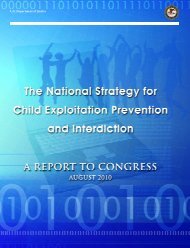Domestic Violence, with a special focus on Human Trafficking
Domestic Violence, with a special focus on Human Trafficking
Domestic Violence, with a special focus on Human Trafficking
Create successful ePaper yourself
Turn your PDF publications into a flip-book with our unique Google optimized e-Paper software.
3. Fear. These women are often c<strong>on</strong>cerned for their ownsafety and the safety of their children, particularly if theyleave the relati<strong>on</strong>ship. When a batterer tells the victim thathe is going to kill her, she and others helping her must takethis threat seriously. A woman is at greatest risk of violenceat the time that she decides to leave her batterer. She is fivetimes more likely to be killed after separati<strong>on</strong> or afterdivorce than when she was still in the relati<strong>on</strong>ship. Thechance of being murdered increases significantly if jealousyis a problem <str<strong>on</strong>g>with</str<strong>on</strong>g> the abuser.In terms of human trafficking, similar reas<strong>on</strong>s: fear, ec<strong>on</strong>omicfactors and acceptance of the situati<strong>on</strong>, may keep a traffickingvictim enslaved. In additi<strong>on</strong>, she may be so poor that she mayfeel compelled to stay and work to feed her family in her homecountry, or a woman forced into sex trafficking may feeltremendous shame and be unable to return to her family whobelieved she had legitimate work in the United States. Thesesevere ec<strong>on</strong>omic and work-related factors are prevalent inhuman trafficking cases, as opposed to domestic violencesituati<strong>on</strong>s. Battered immigrant women and human traffickingvictims also share a host of reas<strong>on</strong>s why they might stay in anabusive relati<strong>on</strong>ship, including isolati<strong>on</strong>, inability to speakEnglish, lack of community or family support, distrust ofgovernment and law enforcement, and a lack of awareness oftheir rights and the resources available to help them.Abusive BehaviorsAbusers have different ways of expressing their abuse.However, to those who care for victims of domestic abuse,there appears to be a repetitive pattern. Abusive behaviors arenoted in Appendix E.N<strong>on</strong>-Violent AlternativesThere are methods for dealing <str<strong>on</strong>g>with</str<strong>on</strong>g> problems in a relati<strong>on</strong>shipthat do not involve abuse. For the most part, this involvesc<strong>on</strong>fr<strong>on</strong>ting the specific problems that are present in a givenrelati<strong>on</strong>ship. It is important to note that “couples counseling”or other joint interventi<strong>on</strong>s rarely work to stop violence, and inmany instances can increase the danger to the victim and herchildren. This is because a perpetrator may retaliate against avictim for her h<strong>on</strong>esty in sessi<strong>on</strong>s or may c<strong>on</strong>tinue tointimidate her so she cannot speak openly in sessi<strong>on</strong>. Theequality wheel depicts qualities of n<strong>on</strong>-violent relati<strong>on</strong>ships.(See Appendix F: Equality Wheel.)<str<strong>on</strong>g>Domestic</str<strong>on</strong>g> <str<strong>on</strong>g>Violence</str<strong>on</strong>g> and Its Potential Effect<strong>on</strong> ChildrenThe effects of domestic violence <strong>on</strong> children can bedevastating. The physician should be alerted to look fordomestic violence when certain problems occur <str<strong>on</strong>g>with</str<strong>on</strong>g> youngchildren and children through their teens.The Use of <str<strong>on</strong>g>Violence</str<strong>on</strong>g> in the FamilyPower and C<strong>on</strong>trolAn abuser primarily uses domestic violence or the threat ofviolence as a means of maintaining power, c<strong>on</strong>trol anddominati<strong>on</strong> over his partner. It is also true that domesticviolence usually becomes more severe over time. Abuse will notsp<strong>on</strong>taneously go away. It often begins <str<strong>on</strong>g>with</str<strong>on</strong>g> verbal abuseincluding remarks intended to belittle the victim or make herlose c<strong>on</strong>fidence in her acti<strong>on</strong>s. It then progresses from badlanguage and shouting to physical and sexual violence. Aperpetrator may be physically abusive <strong>on</strong>ly <strong>on</strong>ce, but thememory of that violence and the threat to use violence againmay be all that is necessary to keep the victim compliant andfearful. Perpetrators are often obsessively or morbidly jealousand will limit the ability of the woman to c<strong>on</strong>tact friends, familyor others in the public, where she might seek help. (SeeAppendix C) Power and C<strong>on</strong>trol Wheel. This abuse can alsoinclude financial abuse before and after a divorce when theabuser <str<strong>on</strong>g>with</str<strong>on</strong>g>holds funds from the victim. Even after a divorcewhen the court requires the abuser to make certain payments tothe victim <strong>on</strong> a timely basis, the abuser can still attempt toc<strong>on</strong>trol a woman by not making payments <strong>on</strong> time. This canhave serious c<strong>on</strong>sequences when her rent or other bills are dueand she does not have funds to make her payments.www.fma<strong>on</strong>line.orgChild abuse and domestic violence frequently existsimultaneously. The most obvious and potentially dangerousrisk for children who live in a home in which there is domesticviolence is that they become direct victims of abuse. In 30 to60 percent of families affected by intimate partner violence,children are also physically abused. [33]<str<strong>on</strong>g>Domestic</str<strong>on</strong>g> <str<strong>on</strong>g>Violence</str<strong>on</strong>g> : In Dating Relati<strong>on</strong>shipsand after DivorceAbuse and tendencies to c<strong>on</strong>trol often become evident in adating relati<strong>on</strong>ship. They are frequently overlooked becausethe victim “loves” her abuser and unrealistically believes orhopes that he will change <strong>on</strong>ce they are married and havechildren. A perpetrator’s c<strong>on</strong>trolling behavior c<strong>on</strong>tinuesthroughout the relati<strong>on</strong>ship. Even after divorce, many menc<strong>on</strong>tinue to c<strong>on</strong>trol the lives of their ex-spouses throughlitigati<strong>on</strong>, child custody/visitati<strong>on</strong> manipulati<strong>on</strong>, or throughthird parties. A perpetrator also can c<strong>on</strong>tinue to exert c<strong>on</strong>trolover his ex-spouse by delaying court-ordered payments (childsupport and/or alim<strong>on</strong>y). This will often result in latepayments and large fees and penalties being assessed againsther, ultimately damaging her credit rating. A woman willresp<strong>on</strong>d differently to direct questi<strong>on</strong>s about violence in herrelati<strong>on</strong>ship depending up<strong>on</strong> her present stage of resp<strong>on</strong>se tothe abuse. Therefore, even after divorce, it is still important toc<strong>on</strong>tinue to ask about her safety and about the safety of herchildren during follow up visits.<str<strong>on</strong>g>Domestic</str<strong>on</strong>g> <str<strong>on</strong>g>Violence</str<strong>on</strong>g> in Florida: <str<strong>on</strong>g>special</str<strong>on</strong>g> <str<strong>on</strong>g>focus</str<strong>on</strong>g> <strong>on</strong> human trafficking15

















